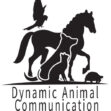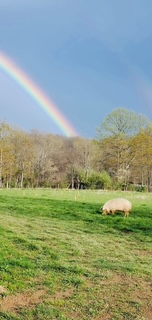I visited Peak Animal Sanctuary last month and sat down to talk with Rayann Sanchez, Director of Operations. Once we concluded our interview, she took me on a tour to meet the animals. It was an amazing experience. I believe the animals would agree with the quote above from the late Pope Francis
How long has Peak been here and how did it start?
The founders, Mark and Michelle, started everything in 2013. We were originally in Salem, IN and moved to Freedom, IN in 2018. Michelle loved birds, like the turkeys and roosters. When I first started, they had retired and moved on and there were 10 big pigs, 5 cows, 6 goats. A lot of the first ones were truck jumpers.
Was there one animal that started everything?
Annie and Andy (pigs). They came from a backyard butcher in Minnesota and got loose. The 3 fosters we currently have were at a backyard factory and 4 of them escaped and were lost in the corn fields. Chicagoland Pig Rescue got them.
The truck jumpers are from factory farming trucks. There is a gestation cage outside our front door. This shows what the mother pig is in when she has babies. She can’t move or do anything. When the babies are 3 weeks old, they gather them all together, crop their tails, do their teeth and ship them to the next fattening stage. When they are 6 months old, they go to slaughter. When the mother can’t produce enough babies, she gets sent to slaughter.
What are some of the biggest challenges you face?
Besides the calls for all kinds of animals? Making sure everyone is comfortable and happy. We keep an eye on how they are walking and sitting. This way we know if they are struggling. We try to make their lives comfortable for them. Getting the word out is also a challenge. We have an Airbnb, people come for tours and we have events twice a year. We try our best to get people to see the animals as individuals.
How do you end up with goats?
One of our residents, Benny, escaped slaughter and was alone in a KY forest for a week before being rescued. Nemo was found in filthy conditions on a barn floor, unable to stand. George is a pygmy goat and the oldest member of our goat herd. He came to PEAK after we received a call that he was abandoned and left tethered in someone’s front yard.
If you got a call today, would you take more animals?
At this time, we are unable to take in more animals. We are doing everything we can to just stay open. We work with other rescues and refer to them. While we do have a potbelly pig here, Sally, we are not able to take anymore potbelly pigs since they are not technically farm food animals. Chicagoland Pig Rescue takes them.
How much time does it take to care for these animals every day?
We start feeding at 9am because our babies are seniors and don’t want to get up early. It usually takes about an hour and a half. Then 10:30 to 12-1pm is cleaning. We clean all the coops, the cow fields, the barn, all the stalls, and pig areas every day. Between 1-3pm is project time. We clean out beds and give the pigs new beds. We focus on the cows and getting them cleaned up. We fix fencing and cut downed trees. Health checks on the birds are done every 3 months. We also cut pig nails and trim goat hooves. We start feeding again at 3pm. We feed all the birds at 3, and the pigs at 4:30. Since we live on property, we come back out and put everyone to bed at sundown so they have the most time outside.
Do you ever get a day off?
We do make time for vacations, but we are mostly are home bodies and are here all the time. We make time for dinner and that’s about it.
How do you deal with the medical cases?
We have 2 vets that come out when needed and we have a place to take the chickens. We vaccinate everyone ourselves.
How do you deal with an animal that comes from abuse and neglect and the emotional trauma comes with that?
Time, and just letting them know that we are here. We find out what they like such as treats or touching. Priscilla, Thelma and Louise, the 3 big pigs, came from a home were there was domestic violence. They were with this woman their whole lives. It took them a long time to trust us. We’d have to put their bowls down and just wait until they were ready to come to them. They wouldn’t let us come near them at first, but eventually they came around. A lot of it is just finding out what each individual likes. Thelma loves belly rubs and Louise is more treat motivated. We spend a lot of time talking to them and gaining trust. It takes patience. They even let us do sunscreen on their ears now.
How do you guys deal with the emotional aspect of this yourselves?
I started doing this years ago in humane societies and I’ve seen lots of bad things with dogs and cats and now these animals. After a while, it gets really hard to like people. We would much rather just be here on the farm building relationships with the animals. Of course, we can’t do that because people are also what sustains us. We have each other to talk to and I can talk with my kids. As long as we get it out somewhere, it helps.
What is your greatest joy or success case?
Andy (pig). I just loved him. When I came here, he didn’t really have anyone. He was by himself. He had a ton of chewing issues and arthritis and couldn’t walk very much and move around. No one could touch him and he didn’t like anyone. I really worked with him. I’ve always been the one to work with bitey chihuahuas and such and it’s no different here. Once you earn their trust, that loyalty just flies out of them. Andy was like that. I would talk to him and pet him a little bit. It got to the point where I could trim his nails, put sunscreen on his ears and brush him. He was my favorite. He was a hard nut to crack.
What was your greatest loss?
Andy. He passed last year. He was down and couldn’t get up so we had to euthanize. That was the hardest one for me.
How can people support you?
We would love for more volunteers to come out and help. They are an extra pair of hands and help get the word out about the animals. We do 2 events every year, one in the spring and a Peaksgiving at the beginning of November. We celebrate the turkeys and everyone gets pumpkins. We also do a silent auction so we are always looking for cool, fun things to put in the auction.
What is the most important thing you would like the public to know?
That we are here! We are in Freedom, Indiana. We have the Airbnb, HipCamp (camping with your tent or RV under the stars, surrounded by nature and the sanctuary residents) and we love to do tours. We really want to get people out here to see what we do and volunteer.
What would you like the public to know about farm animals?
That they have a personality! They have a life and they deserve to live it out. Find other options for food. If people come and meet them, they will see they are sweet. They are so smart. For instance, they recognize that we feed them with black rubber bowls so if you walk out there with a black rubber bowl, they all come running! When we are getting their food ready, all the boys line up on the fence line watching us. We are all vegan here. It’s nice to see vegan options at restaurants and grocery stores now.
Author’s note: Everyone here at Peak Animal Sanctuary is passionate about what they do and they love every animal in their care. You can support them by volunteering, making a one-time donation or becoming a monthly supporter, taking a tour, staying in their Airbnb or camping. High school students can join the LEAP (Leaders for Ethics, Animals & the Planet) program to get hands-on experience with animals, veganism and the environment. Meeting these animals will give you a reason to think about what you put on your plate every day.
Learn more here – https://www.peakanimalsanctuary.org/

